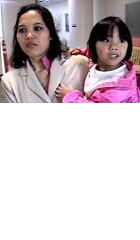
Worlds Apart: A Four-Part Series on Cross-Cultural Healthcare 2003
Distributed by Fanlight Productions, 32 Court St., 21st Floor, Brooklyn, NY 11201; 800-876-1710
Produced by Maren Grainger-Monson, MD, and Julia Haslett, Stanford University Center for Biomedical Ethics (Video Modules); Alexander Green, MD, Joseph Betancourt, MD, MPH, and J. Carrillo, MD, MPH (Facilitator’s Guide)
Director n/a
VHS, color, 4 tapes, 47 min. total
College - Adult
Bioethics, Communication, Education, Health Sciences, Language, Multicultural Studies
Date Entered: 02/04/2004
Reviewed by Sharon Murphy, MLS, RN, Health Sciences Library, State University of New York at BuffaloWhat happens when worlds collide in health care? What happens when patients and health care professionals come together with different perspectives on health, illness, and medicine? This set of four trigger films effectively captures the conflicts that can arise. It does a fine job of meeting its intended goal: to give health care professionals an engaging experience through which to explore ideas about cross-cultural issues in health care and to learn from the actual experiences of both patients and clinicians. These short tapes will provoke discussion. They would be instrumental in any forum to help explore the topic of cultural competence in healthcare and the provision of culturally congruent care – care that meaningfully fits with cultural beliefs and life ways.
Each film tells the story of an individual with serious health concerns, using a highly effective documentary style. We watch as they navigate the health care system and struggle with critical decisions. Four stories are told here: that of a Puerto Rican immigrant woman whose diabetes, hypertension, asthma, and depression are severely affected by her eviction from her New York City apartment of many years; an African-American health policy analyst on dialysis awaiting a kidney transplant, who raises issues of healthcare disparities; a devout Muslim from Afghanistan who is refusing chemotherapy for stomach cancer after surgery, a situation complicated by translator issues; and a young Khmu girl with a congenital heart defect whose family members are refugees from Laos and who wish to make medical decisions in alignment with their cultural beliefs. All are real patients, and their clinical interactions were filmed as they occurred. Authentic and honest, their portrayal is moving and powerful.
The tapes are versatile and would be useful, singly or as a whole, to elicit rich discussion in a wide-range of teaching and learning situations involving healthcare providers. They would be very helpful where different perspectives, values, and beliefs about health and illness may be complicated by communication barriers, especially language and cultural barriers. The films are concise and would serve as effective springboards for discussion on a number of topics. These topics include bioethics, the provision of cross-cultural health care, the care provider – patient relationship, barriers to healthcare, and communication and negotiation skills. Individual tapes could easily be integrated with disease-specific teaching modules (kidney, heart, GI, and multiple-health problem situations). Although the films primarily document interactions occurring with physicians, other health professionals would strongly benefit from the broader perspective it provides and the patient-centered focus.
The video modules are respectful, wonderfully filmed and edited, and graced with thoughtful and appropriate music during the credits. They were produced by a physician/filmmaker and another skilled filmmaker. The audio and video quality is excellent. A superb facilitator’s guide is included. It provides additional background information, greater detail concerning the featured patients’ stories, and excellent summaries of the issues.
This series is highly recommended for academic library collections that serve the health sciences, as well as for hospital libraries. It would be valuable in many clinical settings. Educators and practitioners desiring to examine the important issues surrounding cross-cultural care in our increasingly global world would be well-served by having this series on hand.